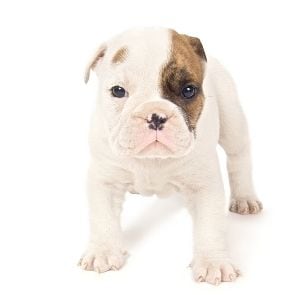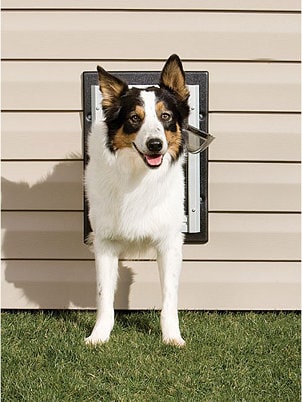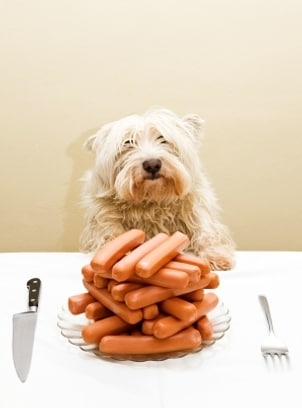LIVING WITH A DOG can be beneficial for children. Dogs can enhance children’s self-esteem, teach them responsibility and help them to learn empathy. However, children and dogs may not always automatically start off with a wonderful relationship. Parents must be willing to teach both the dog and the child acceptable limits of behavior in order to make their interactions pleasant and safe.
Selecting a Dog
What age is best? Many people have a warm and fuzzy image of a puppy and a child growing up together. If you have a young child and are thinking of adopting a puppy (less than 1 year old), there are a few things you need to consider.
•Time and energy: Puppies require a lot of time, patience, training and supervision. They also require socialization in order to become well-adjusted adult dogs. If you have a young child who already requires a lot of care and time, you should ask yourself if you will have enough time to care for a puppy as well.
•Safety: Puppies, because they’re babies, are fragile creatures. A puppy may become frightened, or even injured, by a well-meaning, curious child who wants to constantly pick him up, hug him or pull on his ears or tail.
•Rough play: Puppies have sharp teeth and claws with which they may inadvertently injure a small child. Puppies also tend to jump on small children and knock them down.
•Advantages of getting an adult dog: Adult dogs require less time and attention once they’ve adjusted to your family and household routine, although you’ll still need to spend time helping your new dog with the transition to his new home. You can better gauge how hardy and tolerant an adult dog will be of a child’s enthusiasm.
As a general rule, if your child is under 6 years old, it’s best to adopt a dog that is over 2 years old. Although puppies can be a lot of fun, and it’s exciting and rewarding to help them grow into wonderful companions, they do require significantly more time to train and supervise than an adult dog.
What Breed is Best?
Size. Very small breeds of dogs, such as toy poodles or Chihuahuas, may not be good choices for a young child. These dogs are fragile and may become easily injured when around rambunctious children. Larger dogs or sturdier small breeds, like pugs or beagles, are often better able to tolerate the activity, noise and rough play that are an inevitable part of living with children.
Breed Type. Some of the sporting breeds, such as Labradors and golden retrievers, can make good pets for families with children. Herding breeds, such as border collies and shepherds, are inclined to “herd” children, chasing and nipping at their heels.
Temperament. While generalizations can be made about specific dog breeds, it is just as important to consider a dog’s individual temperament. A dog’s personality is shaped by both past experiences and genetics.
Who Will Care for the Dog?
It’s unrealistic to expect a child, regardless of age, to have sole responsibility of caring for a dog. Dogs need basic things like food, water and shelter, but they also need to be played with, exercised and trained on a consistent basis. Teaching a dog the rules of the house and helping him become a good companion is too overwhelming for a young child. If you’re adopting a dog “for the kids,” you must be prepared and willing to be the dog’s primary caretaker.
Starting Off Right
Holding
•It’s safest for both your child and puppy if your child is sitting down whenever he wants to hold the puppy. Puppies are squirmy and wiggly and may easily fall out of a young child’s arms and be injured. If held insecurely, a puppy may become frightened and snap or nip in response.
•Have your child offer the puppy a toy to chew while being petted. When puppies are teething, they tend to chew on everything, including hands and arms, so having a chew toy handy will divert the puppy’s teeth away from your child.
•For larger dogs, have your child sit in your lap and let the dog approach both of you. This way you can control your child and not allow him to get carried away with pats that are too rough. You are also there to teach your new dog to treat your child gently.
Petting and giving affection: Children often want to hug dogs around the neck. Your dog may view this is as a threatening gesture, rather than an affectionate one, and may react with a growl, snap or bite. It is best to teach your child to pet your dog from underneath the dog’s chin, rather than hugging him or reaching over his head. Also teach your child to avoid staring at, or looking directly into, your dog’s eyes, as your dog may view this as a threat.
Giving Treats: Children tend to become somewhat fearful and anxious when a dog tries to take a treat from their hand. This causes them to jerk their hand away at the last second. The dog may then jump up or lunge to get the treat, which may result in the child being knocked down. Have your child place the treat in an open palm, rather than holding it in his fingers.
Supervising play: Children run with quick, jerky movements and have high-pitched voices. These actions are highly stimulating to a dog. Consequently, your dog may respond by chasing or jumping up on your child. Encourage your child to play quietly around the new dog until both become more comfortable with each other.
Possessions: Your dog won’t know the difference between his toys and your child’s toys until you teach him.
•Your child must take responsibility for keeping his playthings out of your dog’s reach.
•If, and only if, you catch your dog chewing on something he shouldn’t, interrupt the behavior with a loud noise, then give him an acceptable chew toy and praise him lavishly when he takes the toy in his mouth.
•Don’t give your dog objects to play with that could cause confusion, such as old socks, old shoes or old children’s toys that closely resemble items that are off limits. He can’t tell the difference!
•Dogs can be possessive about their food, toys and space. Although it’s normal for a dog to growl or snap to protect these items, it’s not acceptable. At the same time, children need to learn to respect their dog as a living creature who is not to be teased or purposefully hurt and who needs time to himself.
For more information, please visit
www.azhumane.org
Adapted from material originally developed by applied animal behaviorists at the Dumb Friends League, Denver, Colorado
©1999 Dumb Friends League. All rights reserved.








 You want to trim only the portion of the nail that extends beyond the quick, the blood vessel that runs down the nail. On light nails, it is very evident where the quick begins. You will notice a black dot appear in the center of the nail as you clip your small slices. This is the start of the quick. The problem with trimming dark nails is that it's difficult to see the quick. This is why we recommend trimming claws in several small cuts instead of one large cut. On dark nails, you will see a dark or pink dot in the center of the nail as you approach the quick. It will also have a different texture. This is your cue to stop.
You want to trim only the portion of the nail that extends beyond the quick, the blood vessel that runs down the nail. On light nails, it is very evident where the quick begins. You will notice a black dot appear in the center of the nail as you clip your small slices. This is the start of the quick. The problem with trimming dark nails is that it's difficult to see the quick. This is why we recommend trimming claws in several small cuts instead of one large cut. On dark nails, you will see a dark or pink dot in the center of the nail as you approach the quick. It will also have a different texture. This is your cue to stop.  Pick up a paw, position the clipper correctly against the paw and make a series of very thin clips on a 45-degree angle. This is safer than making one large cut.
Pick up a paw, position the clipper correctly against the paw and make a series of very thin clips on a 45-degree angle. This is safer than making one large cut.  Brittle nails can splinter when you clip them. If this happens, file the nail to remove burrs and smooth it. Use several strokes, working from the back of the nail toward the tip. (A dull trimmer can also cause splintered nails; if this is the case, we recommend you replace the blade.)
Brittle nails can splinter when you clip them. If this happens, file the nail to remove burrs and smooth it. Use several strokes, working from the back of the nail toward the tip. (A dull trimmer can also cause splintered nails; if this is the case, we recommend you replace the blade.) 






